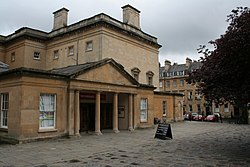| Assembly Rooms | |
|---|---|
 The Assembly Rooms | |
| Location | Bath, England |
| Coordinates | 51°23′10″N 2°21′44″W / 51.38611°N 2.36222°W |
| Built | 1771 |
| Restored | 1963 |
| Restored by | Sir Albert Richardson |
| Architect | John Wood, the Younger |
| Architectural style(s) | Georgian |
| Owner | National Trust |
Listed Building – Grade I | |
| Official name | Assembly Rooms |
| Designated | 12 June 1950[1] |
| Reference no. | 1394144 |
The Bath Assembly Rooms, designed by John Wood the Younger in 1769, are a set of assembly rooms located in the heart of the World Heritage City of Bath in England which are now open to the public as a visitor attraction. They are designated as a Grade I listed building.[1]
During the Georgian era Bath became fashionable, and the architects John Wood, the Elder, and his son laid out new areas of housing for residents and visitors. Assembly rooms had been built early in the 18th century, but a new venue for balls, concerts and gambling was envisaged in the area between Queen Square, The Circus and the Royal Crescent. Robert Adam submitted a proposal that was rejected as too expensive. John Wood, the Younger raised funding through a tontine, and construction started in 1769. The new or upper assembly rooms opened with a grand ball in 1771 and became the hub of fashionable society, being frequented by Jane Austen and Charles Dickens, along with the nobility of the time.
The building, made of Bath stone, is arranged in a U shape. There are four main function rooms in the complex: the 100-foot-long (30 m) ballroom—the largest Georgian interior in Bath; the tea room; the card room; and the octagon. The rooms have Whitefriars crystal chandeliers and are decorated with fine art.
In the 20th century they were used as a cinema and in 1931 were taken over by the Society for the Protection of Ancient Buildings and restored. They were bombed and burnt out during the Second World War, with restoration undertaken by Sir Albert Richardson before reopening in 1963. They are now owned and operated by the National Trust and were operated by Bath and North East Somerset Council for public functions until March 2023. The basement of the building provided a home to the Fashion Museum but this closed in October 2022 after a break clause in the lease was enacted. The exhibits have been placed into storage as the Museum seeks funding for a permanent new home within the city.
- ^ a b Historic England. "Assembly Rooms (1394144)". National Heritage List for England. Retrieved 14 December 2013.
